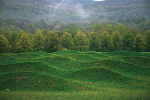Troubleshooting
If the window won’t load, make sure you’ve installed the LabVIEW Runtime Engine, as described here.
If it asked you to find lvsound2.dll , make sure you’ve installed the LabVIEW Runtime Engine, as described here.
If the LabVIEW demo is running, but the background is black, right click on the monitor background and select Properties. Click the Appearance tab and change the Color Scheme to “Default (blue)” or “Olive Green” to fix the problem. The Windows XP “Silver” Color Scheme will cause Live Figures to display with a black background. A reboot may be needed.
Introduction
If you are unfamiliar with LabVIEW, you should be aware that the Live Figures and Demos running in the web page window are executables called Virtual Instruments (VIs). You are interacting with the “front panel” of the VI, which is its graphical user interface.
By default, LabVIEW makes many of the user interface elements adjustable during execution. Therefore, you can click, drag, edit, and right-click various elements and fields of the VI to do such things as change slider ranges, zoom graphs, adjust plot line thickness, etc. If the figure doesn’t show just the right area or value, often you can adjust it. Don’t worry about breaking anything, if you need to restore the original values, just reload the page.
Navigating LabVIEW
Here are a few more specific tips and tricks you can use with LabVIEW.
1. If
you click the STOP (![]() ) button, you can
always restart the demo by clicking the white arrow button (
) button, you can
always restart the demo by clicking the white arrow button (![]() ).
).
2. You can manipulate the plots in several ways.
a. To
the bottom left of a plot is the Graph Palette (![]() ). If it isn’t
visible, right-click the plot and select Visible Items, then select Graph
Palette. You will notice other items under Visible Items. You can also
try playing with them too.
). If it isn’t
visible, right-click the plot and select Visible Items, then select Graph
Palette. You will notice other items under Visible Items. You can also
try playing with them too.
b. Click
the middle icon (![]() ) in the Graph palette, this is the zoom
tool. Several icons will appear. Try selecting one and see what happens.
) in the Graph palette, this is the zoom
tool. Several icons will appear. Try selecting one and see what happens.
c. You can also adjust the plot range directly by double-clicking and editing the first and last scale values. Editing the second and next-to-last scale values lets you change the label spacing.
d. You can usually export the plots to your computer’s clipboard by right-clicking and choosing “Export Simplified Image…”.
3. You can adjust the slider ranges by double-clicking and editing the first and last label values. Note that some Live Figures may produce erroneous results for input values outside the defined slider range.
4. To avoid cluttering the interface of some Live Figures, detailed controls or plots are hidden by default, but can be activated by checking a box labeled “Details” or something similar. The extra controls allow for advanced experimentation.
